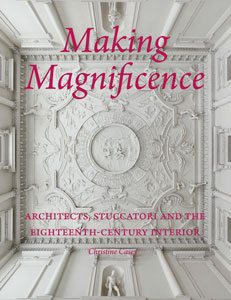
 Christine Casey
Christine Casey
Yale University Press, 2017
pp 320 fully illustrated h/b
$75.00/€70.00 ISBN: 9780300225778
Conor Lucey
While the splendid stucco ornament of the 18th-century country house has long been admired, the supposedly dispensable nature of decoration generally has distorted the historiography of Palladian architecture in Britain and Ireland. In this important and fascinating new book, Christine Casey addresses the contest between ‘taste‚’ and ‘fancy‚’ in the creation of the early modern interior, and for the first time qualifies the considerable achievement of the Ticinese stuccatori within its wider European context.
From the outset, stuccowork is reconstituted as the ‘fundamental composition‚’ of the architectural interior, the author drawing particular attention to the fictive masonry of column and capital, of vault and soffit. In this bold opening move, it is effectively argued that the figurative, representative ornament on ceiling and cove – to which modern eyes are inevitably drawn – obscures the fact that the ‘architecture‚’ of the magnificent interiors at the core of this book is also largely decorative. This crucial point is substantively reinforced throughout the text: a series of ‘observations‚’ compiled by a stuccatore for his patron emphasise design and invention rather than material and technique as his métier, thus amplifying a concern with interior architecture rather than ‘mere‚’ decoration; the active role of architects like Bernini, Filippo Juvarra and Pietro Da Cortona in the ‘design and crafting of their buildings‚’ serves to further underscore the point of the book’s carefully chosen title.
This is a story of people as well as of places. Anxious to delineate the ‘complex culture of entrepreneurship, protectionism and family loyalty‚’, Casey devotes a chapter to the lives of the maestri dei laghi. Its purpose is clear, as identities fostered through geographical and familial propinquity were profound and enduring: kinship dictated the employment of stuccatori by architects from the same pre-Alpine terrain; ‘ghettos‚’ of Ticinese craftsmen appeared across Europe, from Dresden to Rome. The professional formation and business acumen of these individuals is also paramount: a chapter entitled ‘The Stucco Industry‚’ examines, among other topics, the importance of design skills within the apprenticeship system, finding a consonance between the graphic representation of ornament on paper and its ‘intuitive and gestural‚’ translation into plaster.
The remainder of the book is divided into three chapters that explore the work of the maestri in the German-speaking lands of the Holy Roman Empire – here described as the ‘largest and most dynamic market‚’ for stuccowork in 18th-century Europe – and in England and Ireland. Here we discover the origins of the decorative vocabulary practised by the Artari and Lafranchini squadre: the festoon-bearing putti at Carton and Russborough, for example, have their origins in the abbeys and chapels of Fulda, Kremsm√ºnster and Rastatt. And although Ireland clearly represented the ‘endgame‚’ of this decorative phenomenon, it is satisfying to learn that this late iteration, at its best, bears comparison with ‘the finest European work of the period‚’.
Ambitious and insightful, the extraordinary breadth of this book’s scholarship is complemented by writing of great lucidity and literary flourish. As such, it would constitute a magnificent ornament for any architectural library.
Conor Lucey is assistant professor in the School of Art History and Cultural Policy at UCD.



